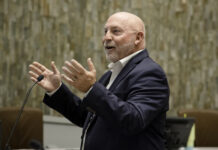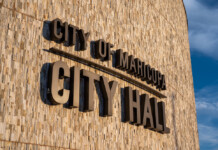
As a precursor to budget talks, the Maricopa City Council received a bleak look at its future revenue.
City Manager Gregory Rose brought in Greg Swartz from Piper Jaffray to explain the city’s primary property tax and why Maricopa will be among the 12 Arizona municipalities losing revenue. By his draft estimates, the loss could be $750,000 to $1.5 million annually.
The state’s 1-percent limit is the primary reason Maricopa is losing revenue, he said.
Swartz said Arizona’s tax system is not only the most complex and confusing in the country, “but in some circumstances is deliberately misleading.”
Constitutionally, homeowners cannot pay more than a combined primary tax that amounts to a $10 rate. In Maricopa, that includes taxes for city, county, college and school districts.
“There is no funding to offset the losses,” Swartz said.
With the tax structure of the state, he said he and other economists see a “big tidal wave of problems” coming. One of those problems is the decreasing assessment ratio for businesses and agriculture. The tax burden, he said, is shifted to residential properties.
Government officials had already received the message that growth would continue to be slow from economic consultant Elliott D. Pollack. The CEO of Elliott D. Pollack and Company presented his economic forecast at a Pinal Partnership breakfast Dec. 12.
Though saying 2015 will be better than 2014 and Arizona is having a “very significant” recovery, Pollack noted the state’s economic issues.
Arizona has fewer people in their peak spending years, slower employment growth and high student loan debt.
“Our rate of growth is so slow compared to what we’re used to, people don’t feel so good about it,” he said.
Potential home buyers have declined 50 percent, according to Pollack.
While single-family housing remains a difficult market, “multi-family housing and apartment outlook could not possibly be better,” he said. But the population is shifting to follow employment.
“We’re going to have to build more roads,” he said. “Everything is jobs.”
A full recovery in housing remains years away, he added, but the slow economy is accelerating.
Maricopa Council member Marvin Brown indicated the outlooks from Swartz and Pollack did not seem to match. “Every year he seems to talk about more rooftops, more housing, ergo economic growth,” Brown said of Pollack’s presentation. “I don’t know how you reconcile his optimism as far as rooftops being the answer.”
Swartz said more construction is only a temporary fix.
“Rooftops are a cost center, and businesses are a profit center. If it weren’t for sales taxes, excise taxes and transaction privilege taxes it would be very difficult to run a government,” Swartz said. “Rooftops by themselves, unless followed by employment opportunities, are just that, cost centers.”
State Aid for Education (SAE) is at 44 percent, keeping school district levies down for homeowners. Swartz said just a percentage point or two lower would put several more municipalities into the revenue-losing box. And the state is likely to decrease SAE.





![Elena Trails releases home renderings An image of one of 56 elevation renderings submitted to Maricopa's planning department for the Elena Trails subdivison. The developer plans to construct 14 different floor plans, with four elevation styles per plan. [City of Maricopa]](https://www.inmaricopa.com/wp-content/uploads/2024/04/city-041724-elena-trails-rendering-218x150.jpg)
![Affordable apartments planned near ‘Restaurant Row’ A blue square highlights the area of the proposed affordable housing development and "Restaurant Row" sitting south of city hall and the Maricopa Police Department. Preliminary architectural drawings were not yet available. [City of Maricopa]](https://www.inmaricopa.com/wp-content/uploads/2024/04/041724-affordable-housing-project-restaurant-row-218x150.jpg)

![City looks to lower property taxes again City Manager Ben Bitter speaks during a Chamber of Commerce event at Global Water Resources on April 11, 2024. Bitter discussed the current state of economic development in Maricopa, as well as hinting at lowering property tax rates again. [Monica D. Spencer]](https://www.inmaricopa.com/wp-content/uploads/2024/04/spencer-041124-ben-bitter-chamber-property-taxes-web-218x150.jpg)



![Alleged car thief released without charges Phoenix police stop a stolen vehicle on April 20, 2024. [Facebook]](https://www.inmaricopa.com/wp-content/uploads/2024/04/IMG_5040-218x150.jpg)


![MHS G.O.A.T. a ‘rookie sleeper’ in NFL draft Arizona Wildcats wide receiver Jacob Cowing speaks to the press after a practice Aug. 11, 2023. [Bryan Mordt]](https://www.inmaricopa.com/wp-content/uploads/2024/04/cowing-overlay-3-100x70.png)

